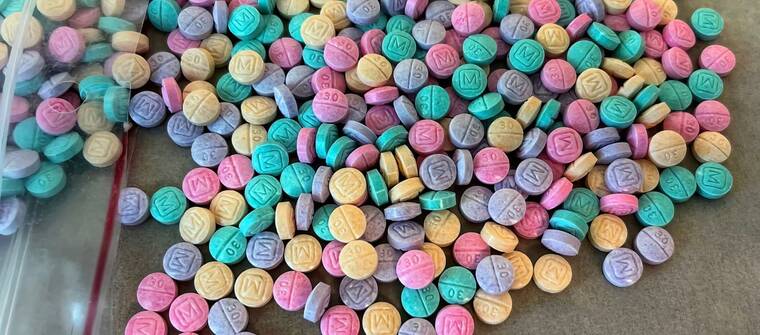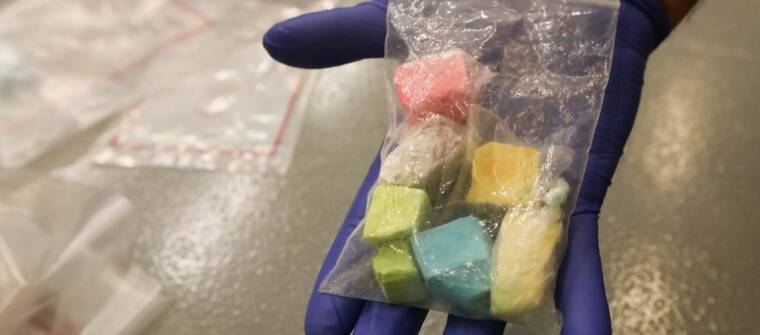‘It’s just a matter of time’: Brightly colored fentanyl used to target young Americans yet to be found on the Big Island
The Drug Enforcement Agency this week warned about “rainbow fentanyl,” a new take on the deadly drug targeting young users that is sweeping the mainland. However, members of the Hawaii Island Fentanyl Task Force and law enforcement have yet to encounter the brightly colored pills and powder on the island.
“We know it’s just a matter of time,” said Dr. Kimo Alameda, task force leader.
The DEA on Tuesday advised the public of an alarming emerging trend of colorful fentanyl available across the United States. In August alone, the brightly-colored fentanyl and fentanyl pills were found in 18 states. Dubbed “rainbow fentanyl” in the media, this trend appears to be a new method used by drug cartels to sell highly addictive and potentially deadly fentanyl made to look like candy to children and young people.
“Rainbow fentanyl — fentanyl pills and powder that come in a variety of bright colors, shapes, and sizes — is a deliberate effort by drug traffickers to drive addiction amongst kids and young adults,” said DEA Administrator Anne Milgram in a press release. “The men and women of the DEA are relentlessly working to stop the trafficking of rainbow fentanyl and defeat the Mexican drug cartels that are responsible for the vast majority of the fentanyl that is being trafficked in the United States.”
Dr. Kevin Kunz, an addiction specialist and task force member, said killer fentanyl has hit the streets of Kona and health care professionals are trying to spread the word to residents that this is a community problem.
“There’s no question that there is more fentanyl here,” said Kunz. “It’s rare to have somebody with an opiate problem that doesn’t have fentanyl on board or have used in the past.”
Last week, Kunz said he had reports from valid sources of three people dying of overdoses on the streets of Kona within a four-day period. Police sources confirmed one of the deaths was a suspected fentanyl overdose, but autopsies are pending. And it could take some time to confirm fentanyl was the cause of deaths as toxicology reports can take months to receive, as in the case of the South Kona youth, whose report took nearly eight months. Prosecutors are still reviewing the case for charges.
Clinical Labs spokesperson Mitsuko Takahashi explained the procedure for toxicology reports.
“We provide autopsy services to the County of Hawaii’s Police Department and send postmortem expanded blood panels, which includes Fentanyl, to NMS Labs, who specializes in postmortem toxicology testing,” she said. “We were notified by NMS Labs that the turnaround time for receiving test results may be longer than usual because of complications of the pandemic.”
Fentanyl is a synthetic opioid that is 50 times more potent than heroin and 100 times more potent than morphine. Just two milligrams of fentanyl, which is equal to 10-15 grains of table salt, is considered a lethal dose. Without laboratory testing, there is no way to know how much fentanyl is concentrated in a pill or powder.
HPD Major Sherry Bird said in a one-year period, Area II, which encompasses Ka‘u, Kona, North and South Kohala, has recovered approximately 5.2 pounds of powdered fentanyl and 2,493 fentanyl pills. The amount of powdered fentanyl alone could kill the population of the Big Island 5.8 times over with 2 milligrams of the synthetic opioid being lethal.
“Our community members are an all important component in battling drugs, to include fentanyl. Education and awareness can assist community members with understanding what this drug is, how it’s used, and the dangers it poses not only to the user but to those who may innocently come across it,” said Bird. “With that awareness piece, our community members will be able to share that knowledge through conversations with family, loved ones, and our young impressionable children, and ultimately discourage the use of drugs and encourage the reporting of illicit activities to adults/police.”
Naloxone, or Narcan can temporarily reverse opioid overdoses and is readily available to community members.
H3RC, formerly known as the Hawaii Health and Harm Reduction Center provides free naloxone through their website: hhhrc.org/naloxone.
“Narcan should be much more available,” said Kunz. “It should be available to school teachers and in school health rooms. All emergency rooms and public clinics should be offering it.”
Kunz said using Narcan revives people that are basically dead.
“So that does not constitute treatment. That is harm reduction and revival,” he said.
EMS Captain Mike Lam said year-to-date there have been 261 calls related to overdoses, including alcohol, over the counter drugs and illicit street drugs. Narcan was used 161 times for opioid overdoses.
“It has been consistent, but we have seen a bump in cases the last three months,” said Lam.
Kunz said all of the folks that are candidates for Narcan because they are using opioids are also candidates for medications for opioid use disorder.
“These are in use around the country and have been around for 20 years. Suboxone doesn’t make you high and takes away craving. It normalizes peoples brains on those opioid receptors so they don’t crave the opiates and don’t keep using the street stuff,” he said.
According to the drug’s manufacture,r Suboxone is in a set of medications referred to as Medications for Opioid Use Disorder (OUD). It is FDA approved, has been for 20 years, and is vastly underutilized, with less than 20% of patients with OUD who could benefit from it receiving it. Every person with OUD should consider it and it should be easily available to them, through clinics, practitioners offices and at the front line of the opioid crisis — in hospital emergency departments.
“The number of people getting it that need it according to the last report is only 16% to 17% of people who would benefit from it are receiving it,” said Kunz.
The CDC reported 107,622 Americans died of drug overdoses in 2021, with 66% of those deaths related to synthetic opioids like fentanyl.
“We have a long way to go. Our hope is that we can get ahead of the curve. We already know on the Big Island we are loosing one person every 11 days per the CDC. It’s not all fentanyl, but the majority is,” said Kunz. “There is help available.”
Kunz said this problem affects every one in the community.
“This crosses the socio-economic line,” he said, noting some people are ashamed to admit they have a problem and delay treatment. “If they want to address their problem they should find a provider that can prescribe Suboxone or ask their primary care provider for a referral for somebody who has expertise in substance use disorders.”



